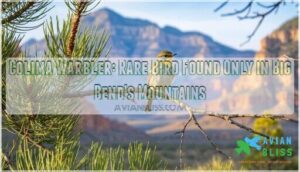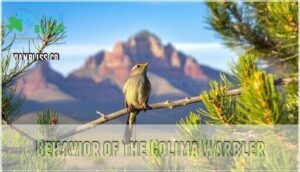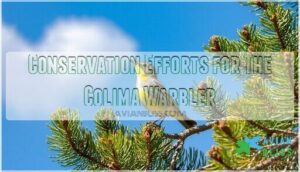This site is supported by our readers. We may earn a commission, at no cost to you, if you purchase through links.

This pale gray songbird sports distinctive yellow highlights on its rump and vent, with males displaying rusty-brown crown patches during breeding season.
Unlike most warblers, it builds ground nests hidden beneath rocks and vegetation, foraging uniquely by probing oak buds and pine flowers for insects.
Present from mid-March through early September, you’ll spot them along challenging mountain trails like Boot Canyon and Green Gulch on north-facing slopes.
Their specialized habitat requirements and restricted range make them both fascinating and vulnerable to environmental changes.
Table Of Contents
- Key Takeaways
- Habitat of The Colima Warbler
- Physical Characteristics of The Colima Warbler
- Behavior of The Colima Warbler
- Where to Find The Colima Warbler
- Conservation Efforts for The Colima Warbler
- Frequently Asked Questions (FAQs)
- What is the rarest warbler in the United States?
- Where can I see Colima Warbler?
- What is the Colima warblers habitat?
- What are some fun facts about the Colima Warbler?
- Where can I see Colima warbler?
- What is the rarest warbler in North America?
- What is the largest warbler in the world?
- Where can I hike to see the Colima warbler?
- What is the most common warbler in North America?
- What is the origin of the Colima Warblers name?
- Conclusion
Key Takeaways
- You’ll find the Colima Warbler only in Big Bend National Park’s Chisos Mountains between 4,900-10,500 feet elevation, making it America’s rarest warbler with fewer than 200 breeding pairs.
- You can identify this pale gray songbird by its distinctive yellow rump and vent markings, plus males display rusty-brown crown patches during breeding season.
- You’ll need to hike challenging mountain trails like Boot Canyon and Green Gulch from mid-March through early September to spot these birds in their specialized habitat.
- You’re witnessing a vulnerable species that builds unique ground nests and faces increasing threats from climate change due to its extremely limited range and specialized habitat requirements.
Habitat of The Colima Warbler
You’ll discover the Colima warbler’s habitat tucked away in the sky islands of Big Bend’s mountains. This warbler species calls montane forests home, specifically pine oak woodlands between 4,900 and 10,500 feet elevation.
Hidden in Big Bend’s remote sky islands, this rare warbler awaits only the most determined birders.
The bird habitat features a mix of Mexican pinyon, Grave’s oak, and Texas madrone trees creating perfect breeding habitat conditions. North-facing slopes provide the ideal setup with shorter trees, tall shrubs, and deep leaf litter where these birds feel at home.
You’ll find them moving between desert scrub at lower elevations and dense woodland canopies above. During nesting season, they seek out talus slopes and rocky areas for ground-level nesting sites.
The warbler’s habitat preferences extend to riparian zones near water sources, where they drink and bathe. This specialized environment creates a unique ecosystem that supports their insect-rich diet and provides the cover they need for successful breeding in Texas’s most remote wilderness.
The Colima warbler’s conservation status is classified as Least Concern status due to its limited range and habitat.
Physical Characteristics of The Colima Warbler
When you first spot a Colima warbler in Big Bend’s mountains, you’ll notice this bird species stands out from other warbler species through its distinctive physical characteristics.
The Colima warbler measures slightly larger than most warblers, comparable to a chickadee in size comparison. Its plumage details reveal a pale gray body with striking yellow highlights on both the vent and rump areas.
Males display a rusty-brown crown patch that serves as one of their most distinct markings, while females show unmarked faces with buffy flanks.
You’ll recognize this bird’s overall pale coloration, which helps it blend seamlessly into desert scrub environments. White eye-rings provide another key identification feature.
During molting patterns, these birds maintain their subtle yet recognizable appearance. The juvenile appearance mirrors adults but with slightly duller tones.
This warbler’s scientific name, Oreothlypis crissalis, actually references those distinctive yellow under-tail coverts that make bird identification easier for observers in the field.
Observing their body proportions can further aid in distinguishing them from similar species.
Behavior of The Colima Warbler
Beyond their distinctive gray-brown plumage, you’ll find colima warbler behavior absolutely fascinating. These bird species exhibit unique foraging strategies, moving deliberately through oak trees like tiny detectives.
Watch these tiny detectives probe oak buds with vireo-like precision, methodically hunting insects.
They probe buds and flowers methodically, gleaning insects and spiders from leaves with vireo-like precision. During spring, they’ll even collect wasp eggs before oaks leaf out.
Their territorial defense is fierce – males sing melodious chirps and trills while physically attacking intruders. You’ll hear their vocalizations echoing through the Chisos Mountains as they establish boundaries.
Nesting habits involve both parents building well-hidden ground nests using grass, bark, and moss under rocks or vegetation. Parental care shows remarkable dedication.
After laying four creamy, brown-spotted eggs, both parents incubate for twelve days. They’ll feed nestlings together, though males focus more on territory protection.
Young birds become independent shortly after leaving the nest at eleven days old. This warbler behavior demonstrates perfect adaptation to their mountain environment.
Their diet consists primarily of insects, aligning with their insect foraging strategies, which is a key aspect of their insect foraging strategies.
Where to Find The Colima Warbler
Finding the Colima Warbler requires dedication and proper planning, as you’ll encounter this rare bird only in specific Big Bend locations.
This elusive mountain bird demands your best hiking boots and unwavering patience.
Head to the Chisos Mountains, where elevation preferences between 6,000 and 7,500 feet create perfect bird habitat. The most reliable Chisos Mountains trails include Boot Canyon and Green Gulch, though you’ll need a full day’s hike or lengthy horseback ride to reach these Texas hotspots.
Seasonal migration patterns affect your chances of spotting this elusive warbler. You’ll find Colima Warblers in Texas from mid-March through early September, with peak bird watching opportunities occurring during spring and summer months. These birds prefer north-facing slopes with dense oak-pine woodlands, often near water sources where they drink and bathe. Like the desert-adapted birds of Arizona, they’ve specific habitat needs.
Remember, no confirmed sightings exist outside Big Bend National Park despite searches in other Texas sky islands, making this truly a once-in-a-lifetime birding destination.
Conservation Efforts for The Colima Warbler
Currently, conservation status for the Colima Warbler remains "Least Concern," but you’ll find this designation doesn’t tell the whole story.
With fewer than 200 pairs in Texas and limited habitat range, wildlife conservation efforts focus on habitat preservation and nest protection within Big Bend National Park.
Population monitoring occurs every five years through citizen science programs, where dedicated volunteers track breeding success and count individuals in Green Gulch and Boot Canyon.
Climate change poses growing threats to their specialized montane oak-pine forests, making avian conservation increasingly critical.
Cross-border initiatives with Mexico promote sustainable forestry practices while restricting cattle grazing in sensitive areas.
These bird conservation efforts include controlled visitor access to nesting sites and ongoing research to understand how environmental changes affect these endangered birds’ breeding patterns and long-term survival prospects.
Parks also utilize Motus tracking systems to gather precise migration and survivorship data.
Frequently Asked Questions (FAQs)
What is the rarest warbler in the United States?
Fewer than 200 pairs of Colima Warblers breed in Texas annually.
You’ll find America’s rarest warbler exclusively in Big Bend National Park’s Chisos Mountains, making it the least known warbler species nationwide.
Where can I see Colima Warbler?
You’ll find Colima Warblers exclusively in Big Bend National Park’s Chisos Mountains above 6,000 feet elevation.
Visit trails like Boot Canyon and Green Gulch from April through August, requiring day-long hikes to reach their oak-pine habitat.
What is the Colima warblers habitat?
You’ll discover Colima Warblers in high-elevation montane forests above 6,000 feet, specifically in pine-oak-juniper woodlands with Mexican pinyon, Texas madrone, and Arizona cypress on north-facing slopes with dense understory cover.
What are some fun facts about the Colima Warbler?
You’ll be amazed this little gray bird only nests in Texas at Big Bend! It’s America’s least-known warbler, requiring day-long hikes to spot in mountain forests above 6,000 feet elevation.
Where can I see Colima warbler?
Like a hidden gem nestled in nature’s treasure chest, you’ll spot this elusive bird only in Big Bend National Park’s Chisos Mountains.
Head to trails like Boot Canyon above 6,000 feet during summer months for your best chance to see it in its natural habitat, making it a unique experience in the Chisos Mountains.
What is the rarest warbler in North America?
You’ll find the Colima Warbler holds that distinction – it’s North America’s rarest warbler, breeding only in Big Bend National Park’s Chisos Mountains with fewer than 200 pairs estimated.
What is the largest warbler in the world?
You’re looking at the Yellow Warbler as the world’s largest warbler species.
These bright songbirds can reach up to 5 inches long and weigh around 4 ounces, making them heavyweight champions among their warbler cousins across the globe, and are considered the largest warbler species.
Where can I hike to see the Colima warbler?
Deep in Big Bend National Park’s Chisos Mountains, you’ll discover North America’s rarest warbler.
Head to Boot Canyon or Green Gulch trails above 6,000 feet elevation for your best chance at spotting these elusive birds.
What is the most common warbler in North America?
You’ll find the Yellow-rumped Warbler is North America’s most common warbler, with populations around 130 million.
This hardy species handles diverse habitats better than other warblers, making it widespread across the continent.
What is the origin of the Colima Warblers name?
You’ll discover the Colima Warbler’s name comes from Sierra Nevada de Colima in Mexico, where scientists first collected this bird species in
Establishing the connection to this specific mountain range location, Sierra Nevada de Colima, is crucial for understanding the bird’s origins.
Conclusion
Like a lighthouse standing solitary against stormy seas, the colima warbler represents nature’s remarkable ability to thrive in isolation.
You’ve discovered a bird that exists nowhere else on Earth except Big Bend’s mountain peaks.
This endemic species faces mounting pressures from climate change and habitat loss.
Your awareness and support for conservation efforts help protect these rare warblers.
When you visit the Chisos Mountains, you’re witnessing something truly special—a living treasure that depends on our stewardship for survival.





